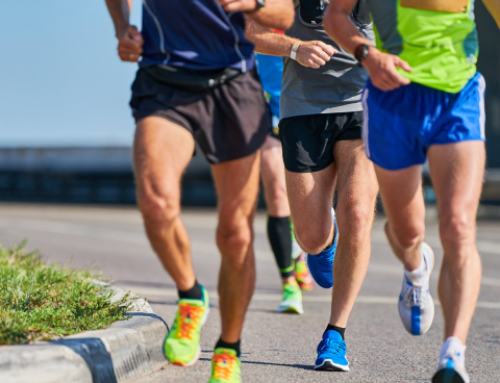8 Speed Workout Tips to Get Faster
![]()
Today’s athletes are faster, stronger and more explosive than ever. Most sports played today involve short- to mid-range acceleration and physical domination. Therefore, both explosive speed and explosive strength are critical. In addition, deceleration and change of direction are a primary focus. A solid strength program will not only help your performance, it will greatly reduce your risk of injury.
Here are a few tips to help you become a faster athlete.
Tip 1: Learn Proper Technique
The best way to become faster and more explosive is to learn proper technique. Proper technique will make you smoother and more efficient. Proper technique should be used at all levels of speed and strength training. Warm-ups, scrimmages, drills, games—no matter what you’re doing, you should always strive to master proper form and technique.
RELATED: The STACK Guide to Sprinting Technique
Tip 2: Focus on Critical Lower-Body Muscles
The most important muscles to work on to get faster are the hamstrings, glutes, abs, lower back, hip flexors and obliques. Strengthening those muscle groups will make you stronger, which in turn will increase your horsepower when sprinting to create a more powerful stride.
Tip 3: Train All Aspects of Speed
Becoming a faster and more explosive athlete requires a complete speed training program, including exercises focused on speed, strength, agility, reaction and coordination. All must be trained on a regular basis. Use tools such as short hill sprints, agility ladders, weight training, change of direction, balance and reaction drills as well as form and technique drills.
RELATED: Sprinters: Improve Each Aspect of Your Speed
Tip 4: Drive Your Arms
When running, arm action is often overlooked. The faster the arms move the faster the legs will move. The shoulders and hands should be relaxed and placed in a 90-degree position. Only the shoulders should move, while the elbows and hands remain locked. The shoulder should act as a sort of hinge, moving the arms in a semicircular motion, bringing the hands from the side of the face to the rear of the hip (cheek to cheek).
Tip 5: Have a Balanced Training Program
Your training routine should be balanced. You should work speed training drills, absolute strength (max effort gym work) and dynamic explosive strength two times per week. You can train more than one area in a day, but work each area only twice weekly. You also must consistently change your exercises and drills, as your body will adapt to a specific task rather quickly. The only way you can get better is to challenge your body and mind to master new tasks.
Tip 6: Train Fast to be Fast
To get faster, you must train with high-speed drills. Running miles or repeat 200’s or even or 50’s is not speed training. Speed training should be set up to simulate the game you play. To become fast and explosive, you must train that way. This typically involves short sprints and explosive drills with rest intervals three to five times longer than your work. Sprinters don’t run miles, they run sprints, lift weight and do acceleration drills.
Tip 7: Don’t Static Stretch
Do not static stretch cold muscles. Before you begin a practice, the best way to warm up properly is to use a dynamic warm-up that moves from basic low intensity movements to faster, more explosive movements. You want to simulate movements you will use in practice or games. Stretching cold muscles actually reduces power output. Thus, cold stretching will make you slower and more prone to injury. Any static stretching should be done after your workout, not before.
Tip 8: Do Plyometrics
There is a direct correlation between jumping ability and speed. That’s why you should do plyometrics, or jump training. This type of exercise trains your muscles to fire quickly, which is critical for all aspects of speed. It also teaches you to absorb elastic energy and release it, which improves your overall power output. You can jump for height, distance, off two feet or one foot, but just make sure you’re jumping.
[cf]skyword_tracking_tag[/cf]RECOMMENDED FOR YOU
MOST POPULAR
8 Speed Workout Tips to Get Faster
![]()
Today’s athletes are faster, stronger and more explosive than ever. Most sports played today involve short- to mid-range acceleration and physical domination. Therefore, both explosive speed and explosive strength are critical. In addition, deceleration and change of direction are a primary focus. A solid strength program will not only help your performance, it will greatly reduce your risk of injury.
Here are a few tips to help you become a faster athlete.
Tip 1: Learn Proper Technique
The best way to become faster and more explosive is to learn proper technique. Proper technique will make you smoother and more efficient. Proper technique should be used at all levels of speed and strength training. Warm-ups, scrimmages, drills, games—no matter what you’re doing, you should always strive to master proper form and technique.
RELATED: The STACK Guide to Sprinting Technique
Tip 2: Focus on Critical Lower-Body Muscles
The most important muscles to work on to get faster are the hamstrings, glutes, abs, lower back, hip flexors and obliques. Strengthening those muscle groups will make you stronger, which in turn will increase your horsepower when sprinting to create a more powerful stride.
Tip 3: Train All Aspects of Speed
Becoming a faster and more explosive athlete requires a complete speed training program, including exercises focused on speed, strength, agility, reaction and coordination. All must be trained on a regular basis. Use tools such as short hill sprints, agility ladders, weight training, change of direction, balance and reaction drills as well as form and technique drills.
RELATED: Sprinters: Improve Each Aspect of Your Speed
Tip 4: Drive Your Arms
When running, arm action is often overlooked. The faster the arms move the faster the legs will move. The shoulders and hands should be relaxed and placed in a 90-degree position. Only the shoulders should move, while the elbows and hands remain locked. The shoulder should act as a sort of hinge, moving the arms in a semicircular motion, bringing the hands from the side of the face to the rear of the hip (cheek to cheek).
Tip 5: Have a Balanced Training Program
Your training routine should be balanced. You should work speed training drills, absolute strength (max effort gym work) and dynamic explosive strength two times per week. You can train more than one area in a day, but work each area only twice weekly. You also must consistently change your exercises and drills, as your body will adapt to a specific task rather quickly. The only way you can get better is to challenge your body and mind to master new tasks.
Tip 6: Train Fast to be Fast
To get faster, you must train with high-speed drills. Running miles or repeat 200’s or even or 50’s is not speed training. Speed training should be set up to simulate the game you play. To become fast and explosive, you must train that way. This typically involves short sprints and explosive drills with rest intervals three to five times longer than your work. Sprinters don’t run miles, they run sprints, lift weight and do acceleration drills.
Tip 7: Don’t Static Stretch
Do not static stretch cold muscles. Before you begin a practice, the best way to warm up properly is to use a dynamic warm-up that moves from basic low intensity movements to faster, more explosive movements. You want to simulate movements you will use in practice or games. Stretching cold muscles actually reduces power output. Thus, cold stretching will make you slower and more prone to injury. Any static stretching should be done after your workout, not before.
Tip 8: Do Plyometrics
There is a direct correlation between jumping ability and speed. That’s why you should do plyometrics, or jump training. This type of exercise trains your muscles to fire quickly, which is critical for all aspects of speed. It also teaches you to absorb elastic energy and release it, which improves your overall power output. You can jump for height, distance, off two feet or one foot, but just make sure you’re jumping.
[cf]skyword_tracking_tag[/cf]










